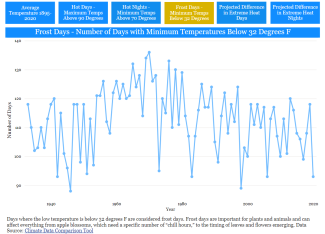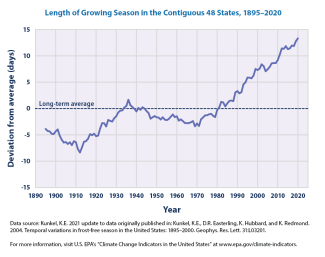Spotlight Data Archives for EPHT
To display or hide the current or previously featured Spolight Data sections on the EPHTN Data page, please click on the corresponding link below.
Key Findings
- On April 8, 2024, a total solar eclipse will cross North America, passing over Mexico, the United States, and Canada.
- Rhode Island will not experience a total solar eclipse, but the state will see a significant partial solar eclipse.
- A solar eclipse happens when the moon passes between the sun and the Earth. When the moon completely blocks the face of the sun, it is called a “total solar eclipse.” When the moon partially blocks the face of the sun, it is called a “partial solar eclipse.”
Why It Matters
Looking directly at the sun is always dangerous and can cause permanent eye damage. Eclipses can be a rare and exciting phenomenon, and it’s important to protect your health while viewing the eclipse. Follow these tips and learn more at health.ri.gov/eclipse.
- Be prepared to view the eclipse. If you’re spending time outside, wear sunscreen and dress appropriately for the weather. Have a plan for how you will view the eclipse.
- Use ISO-compliant eclipse glasses or solar viewing glasses. Always inspect your eclipse glasses or handheld viewer before use; if torn, scratched, or otherwise damaged, do not use the device. Sunglasses are not dark enough to safely view the eclipse.
- Experience the eclipse WITHOUT looking at the sun. Objects with small holes (like a colander/strainer or slotted spoon) will cast a shadow of the eclipse on the ground, this is called an indirect viewing method.
- Supervise children closely, including children using solar eclipse glasses.
- Stay focused while driving. Do not look at the sun while driving. Park in a safe location and use eclipse viewers if you would like to view the eclipse.
View the 2024 Partial Solar Eclipse story map by the Rhode Island Division of Statewide Planning.
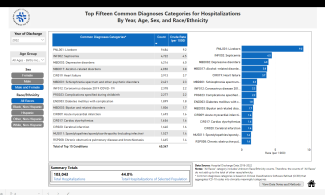
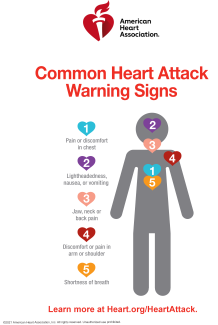
Key Findings
- Cardiovascular diseases (heart disease) are among the top 15 common diagnoses categories for hospitalization in Rhode Island in 2022. For more information, please visit RIDOH’s Hospitalization Discharge Data page.
- Heart failure, acute myocardial infarction (heart attack), and cardiac dysrhythmia (abnormal or irregular heart beat) were among the most common diagnoses categories.
- Research shows that the physical effort of shoveling snow may place extra stress on the heart – and it may lead to an increased risk of heart attack or sudden cardiac arrest.
- Certain conditions, like hypertension and high cholesterol, can increase risk of cardiovascular disease. Data shows the percent of Rhode Islanders with these risk factors has not changed much in the last 10 years.
- Hypertension prevalence has not changed over the last decade. Around 1 in 3 Rhode Islanders (32.9%) report having been diagnosed with hypertension.
- High cholesterol prevalence has changed little during the last decade. Around 1 in 3 Rhode Island adults (33.9%) still have high cholesterol.
Why It Matters
February is American Heart Month. According to the American Heart Association, snow shoveling and cold temperatures can combine to create the perfect storm of heart health hazards. It is especially concerning for people who already have cardiovascular risks like a sedentary lifestyle or obesity, being a current or former smoker, having diabetes, high cholesterol or high blood pressure, as well as people who have had a heart attack or stroke.
There are steps you can take to lower the increased risk from snow shoveling. If you have known or suspected heart disease or risk factors for heart disease, see if someone else can help you with snow removal! If you are shoveling snow, take the following precautions:
- Start slowly and pace yourself. Take breaks and stop shoveling if you are feeling tired, short of breath, or having other symptoms.
- Know the warning signs of heart attack or stroke.
- Wear layered clothing, as well as a hat and gloves. Cover your mouth and nose with a ski mask or scarf to warm the air you breath. Cold air can cause blood vessels to get smaller, which can increase blood pressure.
- Try to push or sweep the snow rather than lifting and throwing it. Pushing snow involves a little less exertion.
- Be extra careful when the wind is blowing. Wind can make the temperature feel even colder than it is and can increase the effects of the cold on your body.
- Use a snow blower if you have access to one and know how to use it. Research shows that using a snow blower raises the heart rate to around 120 beats per minute, compared to a heart rate of around 170 beats per minute from shoveling. You should still be careful to avoid injury while using a snow blower and listen to your body.
Learn more about cardiac arrest and heart attacks and cold weather and cardiovascular disease from the American Heart Association. Learn more from RIDOH about heart disease and stroke.
Key Findings
- Days where the low temperature is below 32 degrees F are called “frost days.”
- The number of frost days has been decreasing since the 1970s.
- Learn more about the analysis from Climate Central.
Why It Matters
In addition to fewer frost days, the first fall frost has been occurring later in the year. These changes mean that the growing season – or the number of days when plants grow – is getting longer. Changes in the growing season can have both positive and negative effects on how much of a crop is grown (called “yield”) and the price it is sold for. Some fruit crops, like apples, blueberries, and peaches, require a chilling period to grown and fruit normally. They require a certain number of “chill hours” or hours below 45 degrees F. If a plant does not experience the required chill hours, it might not bloom on time or produce fruit.
Changes in the growing season also impact allergy-causing weeds, like ragweed. They may grown and produce pollen for a longer time, causing the allergy season to lengthen.
The Fifth National Climate Assessment was recently released by the US Global Change Research Program. Learn more about the assessment’s findings for the Northeast. Use the RIDOH Climate Explorer to interact with data about Rhode Island’s climate.
2005 - 2009
2015 - 2019
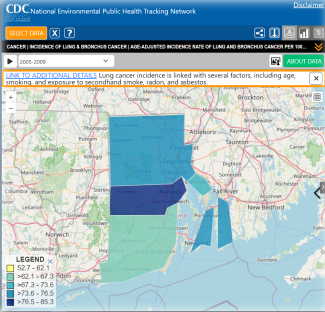
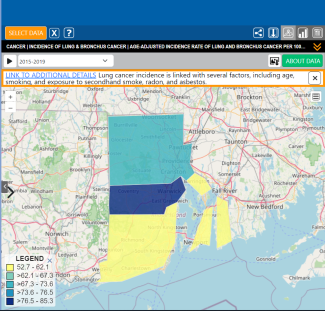
Key Findings
- The maps show the incidence (new cases) of lung and bronchus cancer in Rhode Island over five year periods.
- For example, the incidence of lung and bronchus cancer was 76.5 cases per 100,000 people for 2005-2009 and 68.8 cases per 100,000 people for 2015-2019.
- The data is grouped in five year intervals to meet the requirements of RIDOH’s small number policy.
- The visualization uses age-adjusted rates. Most disease and health outcomes occur at different rates in different age groups. Age-adjustment is a statistical process that removes the bias of age and allows two populations to be compared.
- In many counties in Rhode Island, the incidence rate of lung and bronchus cancer decreased from 2005-2009 to 2015-2019.
- Bristol, Newport, Providence, and Washington counties saw lower rates of new lung and bronchus cancer rates in 2015-2019 compared to 2005-2009.
Why It Matters
November is Lung Cancer Awareness Month. Cancers of the lung and bronchus (lung cancer) are the second most commonly diagnosed malignancies among Rhode Island men and women, accounting for 15% of all cancers reported to the Rhode Island Cancer Registry. A third of cancer-related deaths in Rhode Island are attributed to lung and bronchus cancers.
Certain behaviors and things in the environment can increase the risk of lung cancer. Cigarette smoking is the number one risk factor for lung cancer. Smoke from other people’s cigarettes, pipes, or cigars (called “secondhand smoke”) also causes lung cancer. Radon is the second leading cause of lung cancer in the US. Radon is a naturally-occurring gas that can get into buildings through cracks or holes. Breathing radon over many years can cause lung cancer.
Significant effort has been made to reduce and eliminate risk factors for lung and bronchus cancers. No single change can be identified as having the greatest impact on cancer rates. Efforts have included:
- Smoking cessation and education programs aimed at reducing smoking and vaping,
- Legislation regarding clean indoor air, and
- Evidence-based interventions and policies implemented by the Comprehensive Cancer Control Program.
For more information see:
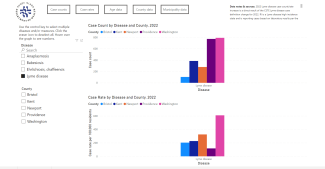
Key Findings
- In 2022, Rhode Island had 2,326 cases of Lyme disease, with an incidence rate of 212 cases per 100,000 people.
- This top graph shows the count (number) of cases of Lyme disease in each in county in 2022. The bottom graph shows the case rate for each county in 2022. The case rate is calculated using the number of cases and number of residents in a county. It is reported as the number of cases per 100,000 people, making it easier to compare counties. Case rates can help show where people are more likely to get Lyme Disease.
- Washington County consistently has the highest rate of Lyme disease in Rhode Island.
- The 2022 case rates by county in Rhode Island were:
- 608.93 cases per 100,000 residents in Washington County,
- 325.05 cases per 100,000 residents in Newport County,
- 226.76 cases per 100,000 residents in Kent County,
- 203.27 cases per 100,000 residents in Bristol County, and
- 117.41 cases per 100,000 residents in Providence County.
- Explore the data in RIDOH's Interactive Data Dashboard for Tick-Borne Diseases
Why It Matters
Lyme Disease is a bacterial infection that can cause fever, headache, fatigue, and a characteristic skin rash and, if left untreated, can spread to joints, the heart, and the nervous system. Lyme disease can be successfully treated with a course of antibiotics.
Lyme Disease is spread through the bite of infected blacklegged (“deer”) ticks in wooded or grassy areas. People are most likely to get bitten by a tick in spring, summer, or fall – however, ticks can survive a mild winter.
The best way to prevent Lyme Disease or other tickborne illness is to prevent tick bites. Ticks can attach to any part of the human body but are often found in hard-to-see areas such as the groin, armpits, and scalp. Check for ticks as soon as possible after coming indoors. If you find a tick, remove it as soon as possible using tweezers or another tick-removing device. Learn more about Lyme Disease and ticks.
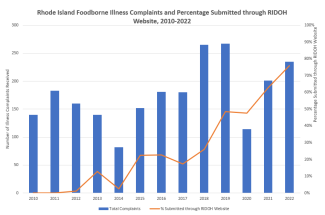
Key Findings
Since 2010, RIDOH has received an average of 177 complaints of foodborne illness each year. People who believe they are sick from something they ate (food poisoning or foodborne illness) should report it through RIDOH’s foodborne illness complaint system either by phone at 401-222-2749 or through our online form.
RIDOH’s online foodborne illness complaint form was developed to make it easier for people to submit complaints as quickly as possible. Foodborne illness complaints using RIDOH’s online form have increased from 0% of complaints in 2010 to 76% in 2022.
Since 2010, 78% of foodborne illness outbreaks in Rhode Island were detected from reports through the foodborne illness complaint system.
Why It Matters
Foodborne illness complaint systems play a vital role in detecting and stopping foodborne illness outbreaks. RIDOH uses the information provided to investigate the complaint and to detect outbreaks of foodborne disease. Reporting a foodborne illness to RIDOH can lead to faster detection of foodborne illness outbreaks, which can stop other people from getting sick too.
The foodborne illness complaint system only works if people use it to report illness. From 2010-2022, the foodborne illness complaint system received an average of 18.1 complaints per 100,000 people. This means that for every 100,000 people in Rhode Island, an average of 18.1 complaints of foodborne illness were reported to RIDOH, and it shows that Rhode Islanders are using the complaint system appropriately.
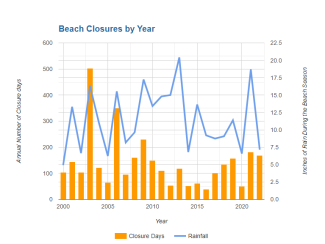
Key Findings
- This graph shows the relationship between rainfall and beach closures.
- Historically, beach closures in Rhode Island have been closely tied to precipitation. Stormwater runoff from roads, parking lots, and other impervious surfaces transports contamination (including bacteria) to our fresh and salt-water bodies.
- From 2000-2009, years with more beach closure days also had rainfall. This trend changes after 2009, when the first of several stormwater improvement and other infrastructure projects was completed.
Why It Matters
The Beach Monitoring Program tests water at the state’s licensed beach facilities to determine if the water is safe for swimming. The program tests the amount (concentration) of Enterocci bacteria in beach water. RIDOH recommends closing beaches for swimming if the bacteria levels are too high because people can get sick.
Numerous municipalities including Barrington, Bristol, and Newport have installed stormwater improvement projects at and around their beaches,. The City of Warwick has removed thousands of cesspools and installed municipal sewer connections in the Oakland Beach area. The Narragansett Bay Commission's "Combined Sewer Overflow Abatement Program" created a system of tunnels beneath Providence that store combined sewer and storm water during heavy rainfall events. The first phase was completed in 2009. Once the storm has subsided, the combined sewer and storm water goes through a wastewater treatment facility before entering Narragansett Bay. While some problems still exist, these cities and towns have seen improved water quality and fewer beach closures as a result. Additional municipalities are in the process of installing systems to improve the quality of water at their beaches.
Learn more at health.ri.gov/beaches.
Key Findings
In early June 2023, smoke from wildfires in Canada impacted air quality across the Northeast and Mid-Atlantic US. During this period, the Rhode Island Department of Environmental Management (DEM) issued air quality alerts for four consecutive days. The alert was lifted on June 9.
Use this interactive map to explore air quality data. The map is set to June 7, 2023. See how air quality changed during the week by clicking on the calendar icon and selecting an earlier or later date.
Why It Matters
The air we breathe is important to our health. The DEM Office of Air Resources forecasts air quality for the state of Rhode Island. Read the latest forecast. People can also check current air quality in their area by downloading the EPA AirNOW application on their smart phone or by visiting airnow.gov.
Fires create very small particles (PM2.5). In fact, they are so small that they can get past the body’s natural defenses and get deep into the lungs. Breathing particle pollution can cause irritation of the eyes, nose, throat and lungs, coughing, sneezing, runny nose, and shortness of breath. Some people are more likely to experience health effects from poor air quality, including people with asthma or other lung disease, people with heart disease, older adults, pregnant women, and children
When an air quality alert has been issued, it’s important to stay informed and take steps to protect your health. Small steps like staying indoors with windows closed, choosing less strenuous outdoor activities, or shortening the amount of time you are active outdoors can reduce the amount of poor air quality you breathe. Air pollution can make asthma and lung disease symptoms worse. People with asthma should carefully follow their asthma management plan on days when pollution levels are high.
To learn more about air quality and health, read RIDOH’s Healthy Air Fact Sheet or visit https://health.ri.gov/asthma/about/airquality/.
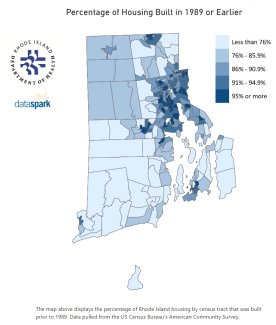
Key Findings
Our homes are connected to our health. Some building materials, like materials that contain asbestos or lead-based paint, can harm our health. Across the state of Rhode Island, the percentage of older homes varies. Older houses are more likely to have been built with asbestos containing-building materials.
Why It Matters
Asbestos fibers do not dissolve in water, and they resist heat and fire. Asbestos can be found in exterior siding, roofing products, vermiculite attic insulation, pipe insulation, drywall, popcorn ceilings, flooring tiles, and more. Asbestos is still present in older building materials and is still used in some products today.
When asbestos-containing materials are damaged or disturbed, asbestos fibers can enter the air. Breathing or swallowing asbestos fibers can cause serious health problems. Do not disturb material that contains asbestos or may contain asbestos. You can't tell if a material does not contain asbestos by looking at it unless it’s glass, wood, or metal. A licensed inspector can test materials that you think might contain asbestos.
Licensed Asbestos Contractors are trained in how to safely remove, repair, encapsulate, or enclose and dispose of asbestos-containing building material. It is recommended that anyone disturbing asbestos works with a licensed Asbestos Contractor. In some buildings, working with a licensed Asbestos Project Designer and Asbestos Contractor is required. Learn more at health.ri.gov/asbestos.

Asthma in Rhode Island
May is Asthma Awareness Month—a time to educate friends, family, and patients about asthma and promote awareness about how this serious, chronic lung disease can be managed.
Key Findings
- This map shows asthma hot spots across a 5 year period with Medicaid claims data. Hot spots are areas where the prevalence of asthma is higher than others.
- More people who live in the 02908, 02909, 02907, and 02905 ZIP codes have asthma during 2015-2019, compared to other areas in the state.
Why It Matters
Asthma makes it hard to breathe, and causes wheezing, coughing, and tightness in the chest. People with mild asthma have attacks that are a minor annoyance. For some people, especially children, asthma attacks can be much worse, even requiring hospitalization.
Asthma cannot be cured, but it can be controlled. Asthma attacks can be avoided by taking medicine exactly as the doctor or other medical professional says and by avoiding triggers that can cause an attack. Things in the environment can trigger asthma attacks or make the condition worse – such as dust, allergens, air pollution and more.
Learn more at health.ri.gov/asthma. If you have asthma, the Asthma Control Program may be able to help.
Climate Explorer Dashboard: Rainfall Totals
Be prepared for April showers! It brings May flowers – but heavy rain can cause flooding, create standing water, and impact drinking water quality.
Water is critical for life. Rainfall fills our lakes and rivers, provides water to plants and animals, and recharges our drinking water sources.
Key Findings
- Rhode Island has seen the highest increase of extreme precipitation in the US since the 1950s.
- The average yearly rainfall total in Rhode Island has increased by 0.45 inches of rain each decade since 1895.
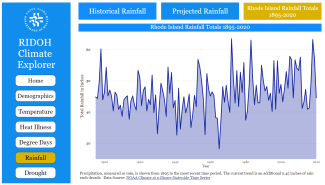
Why It Matters
Climate change can affect the intensity and frequency of rain. We could see both more frequent drought and more intense rain events. Heavy rain can damage crops and increase the risk of flooding. Flooding can damage property, cause mold growth, and cause injury or even death.
Protect your health from damage caused by floods by: knowing the flood risk in your area, making a plan for sheltering and evacuation, and taking care after a flood. Wear protective clothes like masks and work gloves when cleaning after a flood. Avoid walking or driving through flood waters. Just six inches of moving water can knock you down. One foot of water can carry your car away. Turn around, don’t drown!
To know your flood risk, visit FEMA’s Flood Map Service Center. For more information, visit ready.gov/floods.
Learn more about our climate by visiting our Climate Explorer.
Climate Explorer Dashboard: Air Temperature
There are many reasons why we are concerned about air temperatures in Rhode Island. Air temperature can affect everything from human health to our food systems, our forests, our energy use, and severity of droughts and floods.
Key Findings
- Temperatures in Rhode Island are warming, putting us at risk for heat stress illness and other poor health outcomes.
- Rhode Island’s rate of warming is about .3 degrees F per decade. Since 1900, temperatures have risen around three degrees.
- By 2050, we could see 20 more days each year where temperatures are above 90 degrees.
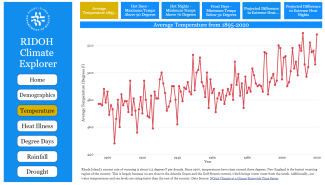
Why It Matters
Climate change will bring changes to Rhode Island’s environment in the form of warmer days, warmer nights, fewer days of freezing temperatures, more drought, and also more rainfall. How these changes impact health will depend on how resilient our bodies and communities are and how we adapt to these changes. Supporting the underlying social determinants of health and making our neighborhoods better able to withstand heat, flooding, and other extreme weather will be an important part of climate change adaptation in the future. Part of the solution will be ensuring that housing is energy efficient, free from fossil fuels, dry and comfortable, and that we have equitable tree canopy, convenient mass transit, and emergency services for all residents.
Learn more about our climate by visiting our Climate Explorer.
February is American Heart Month
February is American Heart Month, a time when all people can focus on their cardiovascular health.
Key Findings
Almost 2 in 5 adults in the United States have high cholesterol (total blood cholesterol ≥ 200 mg/dL). Too much cholesterol puts you at risk for heart disease and stroke, two leading causes of death in the United States.
- In Rhode Island, 30.4% of adults (243,700 people) have been diagnosed with high cholesterol.
- Additionally, 15.4% of Rhode Island adults (131,600 people) do not know their cholesterol status, have never been tested, or have not been tested in the past 5 years and may be at risk for undiagnosed high cholesterol.

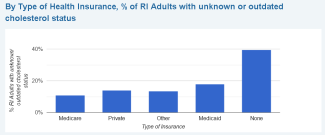
Why It Matters
In Rhode Island, heart disease and stroke cause more deaths among men and women than any other disease, in all racial and ethnic groups. Have your blood tested for cholesterol levels. Ask your doctor how often you should be screened for high cholesterol. Learn more about high cholesterol.
Most high cholesterol is due to health behaviors that people can change, such as eating a lot of unhealthy food or not exercising. Researchers are also investigating if air pollutants like fine particle pollution, also called PM2.5, contribute to high cholesterol levels. Particles can form as the result of emissions from motor vehicles, industry, smoke from wildfires, and other sources of fossil fuel combustion. Extensive studies over the past two decades have shown that air pollution can impact the heart and can cause heart attacks in people with cardiovascular disease. Researchers at EPA are working to better understand the potential links between air quality and high cholesterol. Learn more about air pollution and heart health.
Learn more at health.ri.gov/data/cholesterol/.

January is National Radon Action Month
Key Findings
Radon is a colorless, odorless, radioactive gas. It occurs naturally in rocks and soil and can seep into homes and buildings. One out of four homes tested in Rhode Island has radon above the Environmental Protection Agency action level. That is much higher than the national average of one in 15 homes tested. Rhode Island has more homes with radon above the action level because of the geology of the state.
Why It Matters
Radon is the second leading cause of lung cancer in the US. Testing a home is inexpensive, and it is the only way to know if there is radon. Elevated radon levels can be found in any home: old, new, basement, or no basement. Homes should be tested for radon every three to five years. If radon is detected, it can be addressed with radon mitigation.
Learn more at health.ri.gov/radon.
Carbon Monoxide Poisoning
Age-Adjusted Rate (per 100,000 people) of Emergency Department Visits for Carbon Monoxide Poisoning Not Related to Fire in 2019
Key Findings
Compared to nearby states, Rhode Island had a higher age-adjusted rate of emergency department visits for carbon monoxide poisoning not related to fire in 2019. For every 100,000 people in Rhode Island, an average of 7.87 people visited the emergency department for carbon monoxide poisoning in 2019.
Note on age-adjusted rates: Some health conditions are more common among people in a specific age group. The number of people in a certain age range who live in an area can impact the number of times a certain health event occurs. For example, a neighborhood with more older people living in it would have fewer pregnancies than a neighborhood with more young adults. Using an age-adjusted rate allows public health professionals to see patterns in data that aren’t due to how many people of a certain age live in that area.
Carbon monoxide comes from fuel burning sources including: furnaces, fireplaces, cars, wood stoves, kerosene space heaters, charcoal grills, and gas appliances like water heaters, ovens, and clothes dryers. If installed, maintained, and used properly, these appliances are not a problem.
Why It Matters
Carbon monoxide is a potentially deadly, odorless, tasteless gas. Installing carbon monoxide detectors and regularly changing and testing the batteries can prevent carbon monoxide poisoning.
Health effects from carbon monoxide poisoning can occur over a short or long period of time. Symptoms of carbon monoxide poisoning can include headaches, dizziness, drowsiness, nausea, vomiting, shortness of breath, and tightness across the chest. Carbon monoxide poisoning can cause permanent damage to parts of your body that require a lot of oxygen, such as the heart and brain, and may result in neurological damage, illness, coma, or death.
Learn more about carbon monoxide at https://health.ri.gov/healthrisks/poisoning/carbonmonoxide/
Using Food Illness Complaints to Detect Outbreaks
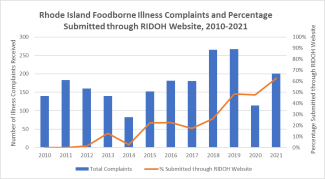
Key Findings
Since 2010, RIDOH has received an average of 172 complaints of foodborne illness each year. People who believe they are sick from something they ate (food poisoning or foodborne illness) should report it through RIDOH’s foodborne illness complaint system either by phone at 401-222-2749 or through our online form.
RIDOH’s online foodborne illness complaint form was developed to make it easier for people to submit complaints as quickly as possible. Foodborne illness complaints using RIDOH’s online form have increased from 0% of complaints in 2010 to 63% in 2021.
Since 2010, 77% of foodborne illness outbreaks in Rhode Island were detected from reports through the foodborne illness complaint system.
Why It Matters
Foodborne illness complaint systems play a vital role in detecting and stopping foodborne illness outbreaks. RIDOH uses the information provided to investigate the complaint and to detect outbreaks of foodborne disease. Reporting a foodborne illness to RIDOH can lead to faster detection of foodborne illness outbreaks, which can stop other people from getting sick too.
The foodborne illness complaint system only works if people use it to report illness. From 2010-2021, the foodborne illness complaint system received an average of 16.3 complaints per 100,000 people. This means that for every 100,000 people in Rhode Island, an average of 16.3 complaints of foodborne illness were reported to RIDOH, and it shows that Rhode Islanders are using the complaint system appropriately.
Key Findings
A heat mapping project in summer 2020 found that certain locations across Providence, East Providence, Pawtucket, and Central Falls can be up to 12 degrees hotter than other locations in the area.
While anyone can experience heat-related illness, men are more likely to visit the emergency department and to be hospitalized than women.
Why It Matters
Normally, when you get hot, your body cools itself by sweating. When it is very hot and humid, sweating isn't enough and the body temperature rises. Very high body temperatures can cause heat-related illness that may damage organs or cause death. Some people are more at risk of developing heat-related illness because of their age or medical condition. People may experience more extreme heat if they work outside or live in a hotter area.
The high temperatures that can cause heat-related illness are happening more often, becoming more intense, and lasting longer. During a heat event last month, Providence set a new record high temperature for July 24 of 98 degrees. The previous record for this day was 94 degrees, set in 1933.
Visit https://health.ri.gov/climate-change/extreme-heat to learn more about what to do during extreme heat.
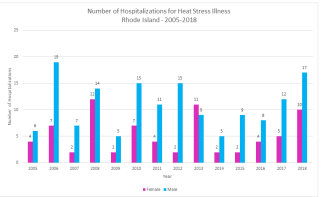
States with Indoor Tanning Restrictions for Minors, 2009 vs 2021

Key Findings
In 2009, only five states had any laws restricting minors from indoor tanning. By 2021, only five states did NOT have any laws restricting minors from indoor tanning.
Since 2013, children under 18 have been banned from using indoor tanning facilities in Rhode Island unless their parents sign a written consent that includes information about the cancer risks of tanning.
In 2018, Rhode Island passed a law to ban minors from using tanning facilities. The Rhode Island legislation (2018-S 2299B, 2018-H 7136) passed by the Senate eliminated the parental consent option, and also removes an exemption that currently allows minors with a doctor’s prescription to use tanning facilities.
Why It Matters
According to the Skin Cancer Foundation, just one indoor tanning session before the age of 35 increases a person’s risk of melanoma, the deadliest form of skin cancer, by 75 percent. One study observing 63 women diagnosed with melanoma before age 30 found that 61 of them (97 percent) had used tanning beds.
Learn more about skin cancer and how you can protect yourself and your family. Visit the CDC Melanoma Dashboard for additional information.
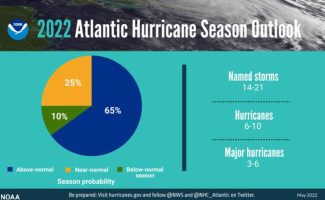
Spotlight Topic
The Atlantic Hurricane Season is from June 1 through November 30. Learn more about this year’s Hurricane activity forecast and steps you can take to prepare for hurricanes.
Hurricanes can cause illness, injury, damage to houses and buildings, and environmental health concerns like mold. They also cause significant indirect health impacts that can be experienced long after the storm itself.
Forecasting from the National Oceanic and Atmospheric Administration (NOAA) suggests that the 2022 Atlantic Hurricane Season will have higher than normal activity.
Key Findings
This year NOAA forecasts 14 to 21 named storms, of which 6 to 10 could become hurricanes, and 3 to 6 could become major hurricanes. Based on NOAA forecasts, this will be the seventh consecutive hurricane season with higher-than-normal activity.
Why It Matters
While it is impossible to predict the exact activity of an upcoming hurricane season, studying the ocean and atmosphere features can help people take important preparedness steps. Being prepared for a hurricane can limit the negative impact on physical, mental, financial, and environmental health.
There are three steps you can take now to protect your health from the effects of hurricanes: Make a plan, build a kit, and stay informed.
Make a plan
- Complete the My Emergency Plan Workbook
- If you or someone in your family has a special healthcare need, and may need extra help in an emergency, enroll in the Rhode Island Special Needs Emergency Registry. Learn more about the Rhode Island Special Needs Emergency Registry and enroll now.
Build a kit
- When a disaster or emergency occurs, you may need to survive on your own for a few days. Being prepared means that you have the items you will need (food, water, medications, etc.) ready so that you can survive for several days after an emergency. A disaster supplies kit is a collection of basic items your household may need in the event of an emergency. For ideas about what to put in your kit, visit: https://www.ready.gov/kit
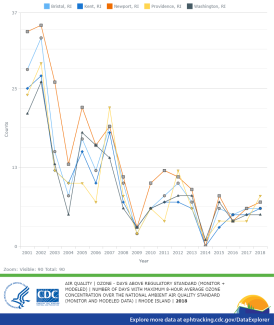
Spotlight Topic
May is Asthma Awareness month. People with asthma are at higher risk of health effects from poor air quality. Learn more about how you can reduce the asthma triggers that affect you and your family.
Ground-level ozone is one air pollutant that can trigger asthma attacks. Ozone can reduce lung function and is very irritating to the lungs and airways. It is well known that ozone concentration is directly related to asthma attacks. Increased use of asthma medicine and emergency treatment for asthma are seen on days with high ozone. health effects of ozone polution
What's the State of YOUR Air? For 23 years, the American Lung Association has analyzed data from official air quality monitors to compile the State of the Air report. The more you learn about the air you breathe, the more you can protect your health and take steps to make the air cleaner and healthier. Click here to review the 2022 Rhode Island report card.
Key Findings
The data shows that while the number of days with high ground-level ozone in Rhode Island has been declining over the last two decades, there are still a number of days each summer when the ozone level is unhealthy.
Why It Matters
Ozone in the air we breath can harm our health and can worsen symptoms of emphysema, asthma, and other lung conditions. People at risk from breathing air containing ozone include children, older adults, outdoor workers, and others who are active outdoors or who have asthma. Learn more about outdoor air quality.
March is Colorectal Cancer Awareness month. Select 'Colorectal' from the type dropdown in the visual and see how Rhode Island rates per 100,00 has declined from 60.3 to 31.5 per 100,000 from 1995 - 2017.
Among cancers that affect both men and women, colorectal cancer is the second leading cancer killer in the US. If everyone aged 50 years or older had regular screening tests, many deaths from this cancer might be avoided. This is because screening tests can often find colorectal cancer early, when treatment works best.

